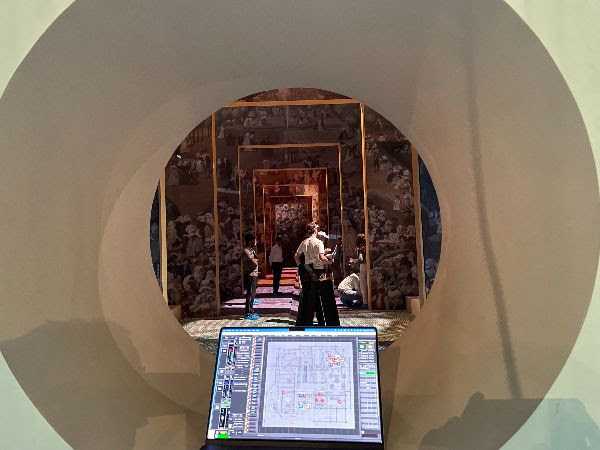TiMax SoundHub zones in on India in Fashion
- Details

Kapil Thirwani, director of Munro Acoustics was tasked with fulfilling the audio brief which demanded an array of immersive soundscapes that segued from zone to zone. Calling upon the expertise of distributor, Alphatec, he quickly discovered that only the capabilities of TiMax SoundHub would meet the complexity of the audio solution in its entirety.
The exhibition is curated by Vogue’s global editor, Hamish Bowles and presents a multi-zone exploration into the impact of India on global fashion and vice versa. Thirwani was contacted to deliver the audio solution in an eye-wateringly tight timeframe. On advice from Alphatec, who distribute TiMax across India, Thirwani had just enough time to fly to ISE in Barcelona to discuss the project in detail with Out Board.
Out Board director, Dave Haydon, explains: “Alphatec showed Kapil various ways TiMax could handle this project, which involved playing spatial music and effects across 15 different zones, starting and stopping it all automatically without anybody having to touch it. He worked out that TiMax was the only thing that could do it all at once.”
Thirwani’s mission was a success and the final installed solution saw two 64 i/o TiMax SoundHub-S64s each handle one half of the exhibition, playing out a mix of stereo and multi-stem spatial music as well as soundscape tracks to 128 Genelec 4430 IP speakers across 15 zones. Genelec is also distributed by Alphatec.
The Genelec 4430 is a small but powerful, self-powered, Smart IP installation speaker which, like TiMax connects to a Dante network and supports external control via third-party hardware or software. Each running on a single Cat 5 cable, the self-powered Genelec speakers were not only discreet but avoided the use of over 20km of expensive and hard-to-conceal copper wiring.
The soundscapes for the individual exhibition zones were originated by Goa-based musicians Sandunes. With some multi-channel spatial audio tuition from Haydon in hand, the duo cleverly created audio content in the same key which served to prevent musical clashes from one zone to another. Various show content stems were sent to the UK where OutBoard’s Haydon could begin programming the showfiles, and he subsequently visited Mumbai to help Sandunes bed in the immersive content on-site.
Without walls between the exhibits, overlap was unavoidable but once the audio installation was complete, the team started auditioning the soundscapes over the various zone speaker systems, walking from zone to zone with a Mac to fine-tune them.
Following this process all the settings were saved and the SoundHubs locked. Set to fade up at 10am and then slowly fade out at the end of the day, simplified client control for the TiMax-controlled system was provided via a TouchOSC iPad for each SoundHub. Changes could be made to master level and individual zone levels for out-of-hours VIP visits, press and TV interviews without impacting the saved set-up.
Arriving at the completed project shortly before it opened to the public, Haydon says: “The integration and design were amazing, and all the equipment was up and running to provide totally automated, hands-free, fully integrated show-in-a-box operation.”
Giving testament to the stability of the TiMax system and its ease of use, Thirwani notes: “The entire show ran for two months with no issues at all.”









